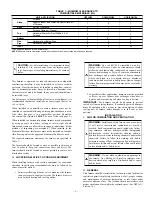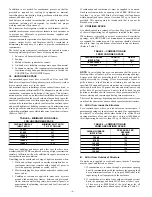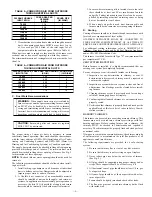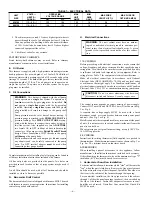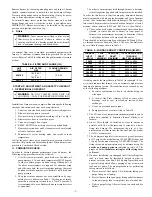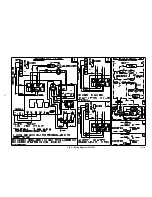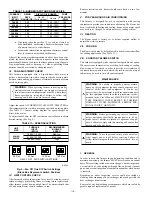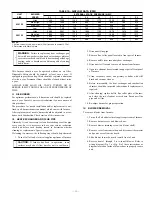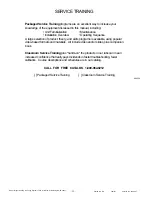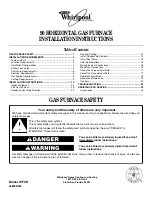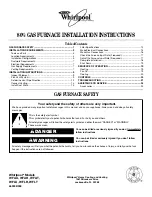
WARNING:
Failure to replace any heat exchanger gas-
kets with new gaskets when any heat exchanger plates or
covers are removed could lead to heat exchanger leakage,
sooting, and/or a hazardous condition capable of causing
bodily harm.
This furnace should never be operated without an air filter.
Disposable filters should be replaced at least once a year. If
equipped to provide cooling, filters should be replaced a minimum
of twice a year. Permanent filters should be cleaned at least twice
a year.
ALWAYS KEEP MAIN OIL VALVE TURNED OFF IF
BURNER IS SHUT DOWN FOR AN EXTENDED PERIOD OF
TIME.
II.
OIL BURNER
For optimum performance, oil burner nozzle should be replaced
once a year. Contact your service technician if you are unsure of
this procedure.
The procedure for nozzle installation and/or replacement is out-
lined in oil burner instruction manual which came with furnace.
After replacement of nozzle, burner should be adjusted in accor-
dance with Combustion Check section of this instruction.
III.
HEAT EXCHANGER AND FLUE PIPE
Ordinarily, it is not necessary to clean heat exchanger or flue pipe
every year, but it is necessary to have your service technician
check unit before each heating season to determine whether
cleaning or replacement of parts is required.
If cleaning is necessary, the following steps should be performed:
1. Turn off all oil and electrical supplies upstream of furnace.
CAUTION:
If furnace has been in operation, some
surfaces may be hot. Allow time for unit to cool down.
2. Disconnect flue pipe.
3. Remove flue collar panel located in front part of furnace.
4. Remove baffle from secondary heat exchanger.
5. Disconnect oil line and remove oil burner from furnace.
6. Open two cleanout doors located in upper part of front panel
of furnace.
7. Clean secondary tubes, and primary cylinder with stiff
brush and vacuum cleaner.
8. Before re-assembly, the heat exchanger and combustion
chamber should be inspected to determine if replacement is
required.
9. After cleaning, replace baffle, flue collar plate, oil burner,
and close the two cleanout access doors. Reconnect flue
pipe and oil line.
10. Re-adjust burner for proper operation.
IV.
BLOWER REMOVAL
To remove blower from furnace:
1. Turn off all oil and electrical supplies upstream of furnace.
2. Remove burner access and blower door.
3. Remove blower retaining screw (on blower shelf).
4. Remove cover from control box and disconnect thermostat
and power wires from the board.
5. Slide blower forward on rails toward front of unit.
6. Reverse items 1 through 5 to re-install blower. Refer to
wiring diagram (Fig. 3 or Fig. 4) of these instructions or
diagram located on inside of blower door to properly rewire
unit.
TABLE 12—AIRFLOW DATA (CFM)
UNIT
SIZE
BLOWER
SPEED
EXTERNAL STATIC PRESSURE IN. WC
0.2
0.3
0.4
0.5
0.6
0.7
0.8
0.9
036105
High
1425
1350
1305
1250
1170
1030
925
805
Med-High
1130
1045
1000
950
885
820
745
670
Med-Low
840
810
770
740
685
635
580
500
Low
725
730
740
745
730
715
690
665
060120
High
2080
2041
1965
1864
1702
1576
1474
1336
Med-High
1892
1859
1770
1675
1550
1449
1330
1217
Med-Low
1556
1475
1394
1318
1211
1134
1051
938
Low
1221
1164
1081
998
926
855
782
653
NOTES:
1. Airflow values in cubic ft per minute (CFM) rounded to nearest 5 CFM.
2. Data taken with filters in place.
—11—



